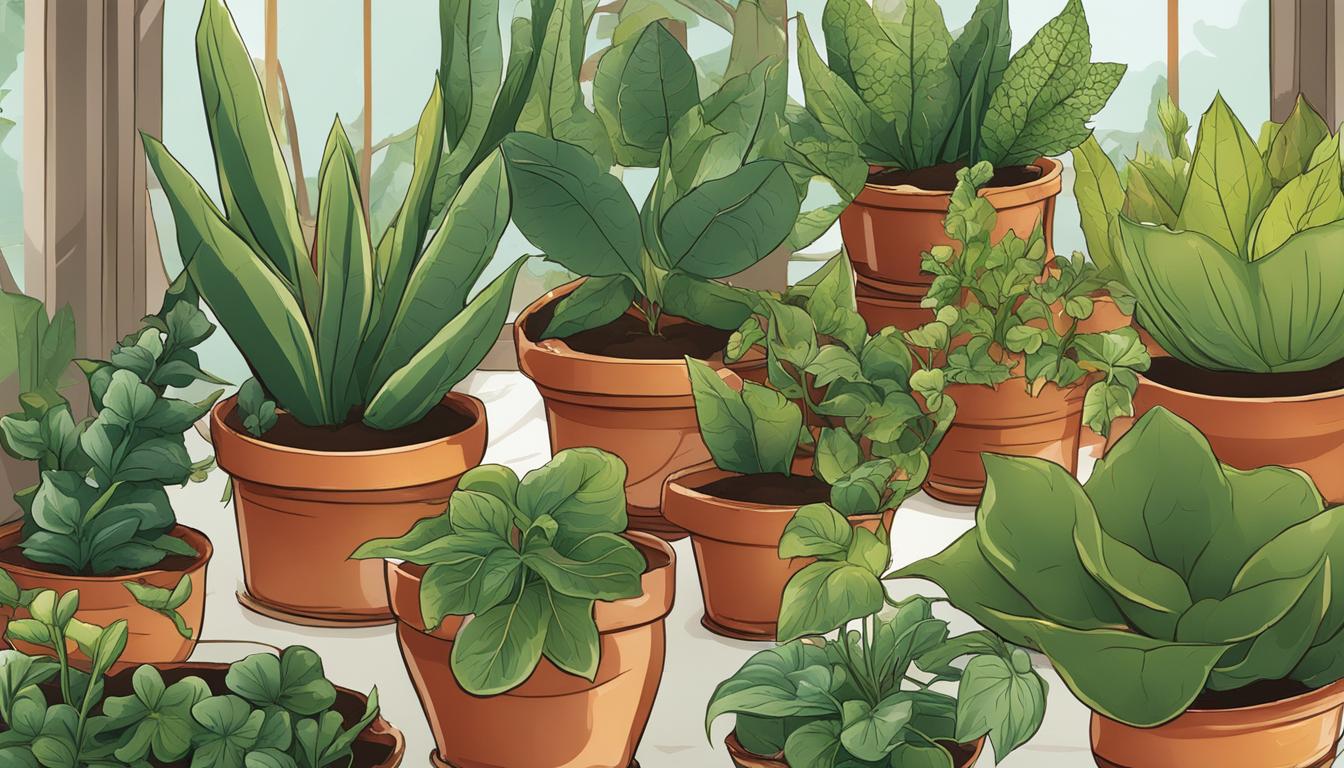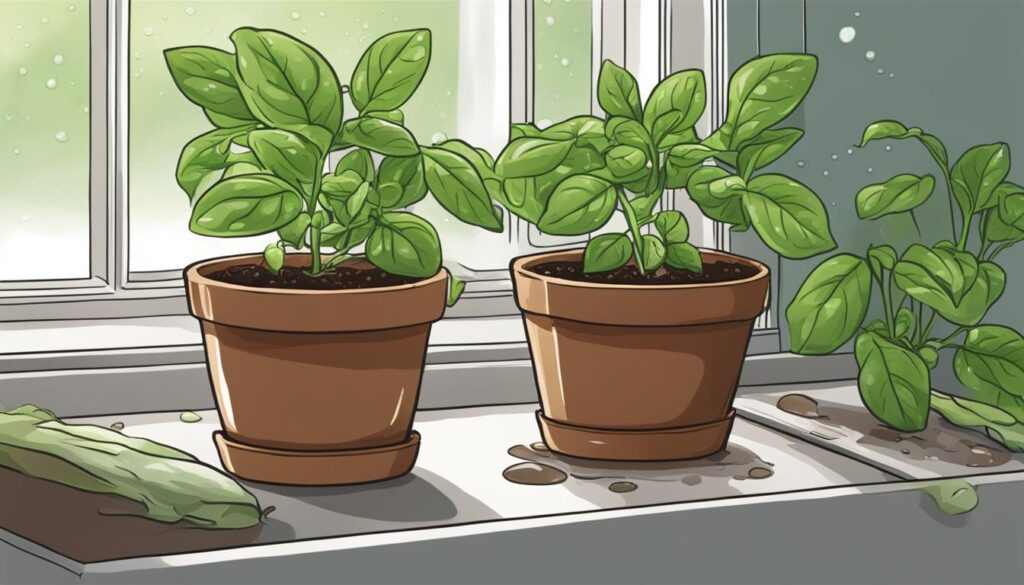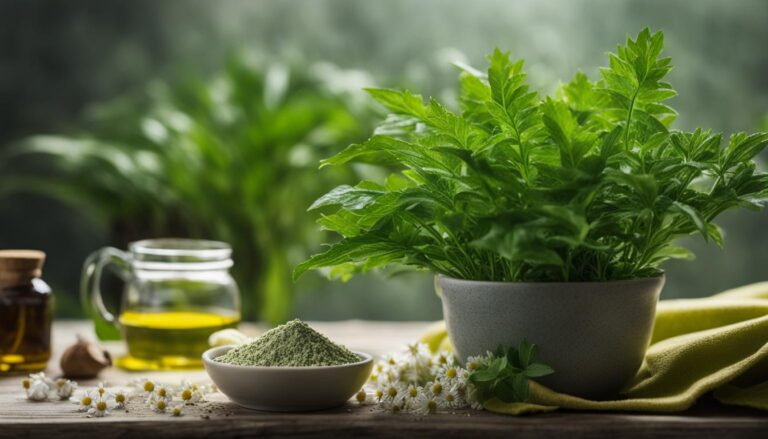
Fall is officially here and that means that gardening is coming to a halt for the year. Indoor gardening is a great way to continue nurturing plants and reaping the benefits of medicinal herbs even during the colder months.
In this article, I will explore the best medicinal plants for indoor growing, providing you with a guide to bringing nature and wellness into your home.
Key Takeaways:
- Indoor gardening allows you to continue growing medicinal plants even during the colder months.
- Aloe, basil, catnip, lemongrass, lemon balm, mint, oregano, parsley, sage, rosemary, and thyme are some of the best medicinal plants for indoor growing.
- These plants offer a range of health benefits and can be easily grown indoors with proper care.
- Indoor gardening allows you to have fresh herbs and natural remedies at your fingertips.
- Consider the lighting and soil requirements of each plant when setting up your indoor garden.
Aloe
Aloe is a versatile and easy-to-grow plant that offers a multitude of healing benefits. It accelerates the healing of burns, treats mouth ulcers, reduces constipation, and boosts the immune system. Aloe plants thrive indoors, making them an ideal choice for indoor gardening. They require indirect sunlight and well-draining soil.
With its succulent leaves and gel-like substance, aloe is a popular plant for its therapeutic properties. It has been used for centuries to treat various ailments and promote overall wellness. The healing properties of aloe can be attributed to its rich composition of vitamins, minerals, and antioxidants.
One of the key benefits of growing aloe indoors is its ability to purify the air. Aloe plants naturally remove toxins from the environment, making them a great addition to any indoor space. In addition to their healing properties, aloe plants are also low-maintenance and require minimal care.
Benefits of Aloe:
- Accelerates the healing of burns
- Treats mouth ulcers
- Reduces constipation
- Boosts the immune system
| Light | Water | Soil | Temperature |
|---|---|---|---|
| Indirect sunlight | Allow soil to dry out between waterings | Well-draining soil | 65-75°F (18-24°C) |
Basil: A Versatile Medicinal Plant for Indoor Growing
Basil is not only a popular culinary herb but also a powerful medicinal plant that offers a range of health benefits. It has natural anti-inflammatory properties, is high in antioxidants, and can be used to soothe the stomach and relieve insect bites. Growing basil indoors is relatively easy, making it a perfect addition to your indoor garden.
When it comes to medicinal uses, basil has been traditionally used to alleviate digestive issues such as bloating and indigestion. Its natural compounds help to reduce inflammation in the digestive tract, promoting healthy digestion. Basil also has antimicrobial properties that can help fight off harmful bacteria.
Medicinal Uses of Basil
- Anti-inflammatory: Basil contains essential oils, such as eugenol, that have anti-inflammatory effects on the body. It can help reduce inflammation and pain caused by conditions like arthritis.
- Antioxidant: The antioxidants in basil help protect the body against damage from free radicals, which can contribute to chronic diseases.
- Stomach Soother: Basil has been used for centuries to relieve stomach discomfort, including bloating, gas, and indigestion.
- Insect Bite Relief: Applying basil oil or a crushed basil leaf to insect bites can help reduce itching and inflammation.
Growing basil indoors requires a well-lit location with at least six hours of sunlight per day. You can start with seeds or young plants from a nursery. Basil prefers well-draining soil and should be watered when the top inch of soil feels dry. Regularly pinching off the leaves will encourage bushier growth.
By growing basil indoors, you can have a fresh supply of this versatile medicinal herb all year round. Whether you use it in recipes or for its healing properties, basil is a valuable addition to any indoor garden.

Catnip: A Versatile Indoor Medicinal Plant
Catnip, also known as Nepeta cataria, is a popular herb with a range of health benefits. It is well-known for its calming properties and is commonly used to soothe nerves and promote relaxation. But did you know that catnip has many other medicinal uses? From alleviating menstrual cramps to improving digestion, this versatile plant is a valuable addition to any indoor garden.
When it comes to growing catnip indoors, it is relatively simple and requires minimal maintenance. Catnip thrives in a sunny window or under artificial lighting, making it a perfect choice for indoor gardening.
It prefers well-draining soil and should be watered regularly to keep the soil slightly moist. With proper care, you can enjoy an abundance of fresh catnip leaves throughout the year.
In addition to its health benefits, catnip also has numerous practical uses. Cat owners will be familiar with its ability to attract and stimulate cats, making it a popular choice for cat toys and treats. The aromatic oils found in catnip can also be used to repel insects, making it a natural alternative to chemical-laden bug sprays.
To give you a better understanding of the benefits and uses of catnip, take a look at the table below:
| Health Benefits of Catnip | Uses of Catnip |
|---|---|
| Calms nerves and promotes relaxation | Relieves menstrual cramps |
| Improves digestion | Repels insects |
| Alleviates migraines | Attracts and stimulates cats |
| Soothes upset stomach | Natural alternative to bug sprays |
As you can see, catnip is more than just a favorite herb among feline friends. Its medicinal properties and practical uses make it a valuable addition to any indoor garden. Whether you’re looking to relax, relieve menstrual cramps, or keep insects at bay, catnip is here to help.
Lemongrass: A Versatile Medicinal Plant for Indoor Growing

Lemongrass is not just a flavorful herb used in various cuisines, but it also offers numerous health benefits. Growing lemongrass indoors allows you to have easy access to this versatile medicinal plant throughout the year.
Whether you want to promote healthy digestion, reduce arthritis pain, control cholesterol levels, detoxify your body, or boost your vitamin C intake, lemongrass is a valuable addition to your indoor garden.
When it comes to growing lemongrass indoors, it is essential to provide it with the right conditions for optimal growth. Lemongrass requires a warm and sunny location, so make sure to place it near a window where it can receive ample sunlight. If natural light is limited, you can also use artificial lighting to ensure the plant gets the necessary amount of light.
In terms of care, lemongrass prefers well-draining soil and regular watering. It is important to keep the soil evenly moist but not soggy, as overwatering can lead to root rot. Additionally, you can fertilize the plant every few weeks with a balanced fertilizer to promote healthy growth.
Whether you want to enjoy the refreshing aroma of lemongrass in your home or harness its medicinal benefits, growing lemongrass indoors is a rewarding and accessible gardening endeavor.
Lemon Balm: A Versatile Medicinal Herb for Indoor Growing
Growing lemon balm indoors is a rewarding and straightforward experience. This versatile medicinal herb offers a range of health benefits and can be easily incorporated into your indoor garden. Lemon balm, also known as Melissa officinalis, is a member of the mint family and is native to the Mediterranean region.
The use of lemon balm dates back thousands of years, with its name derived from the Greek word “melissa,” meaning honeybee. In ancient times, lemon balm was often used to attract bees for honey production. Today, lemon balm is prized for its calming effects and its ability to promote relaxation and reduce stress.
Lemon balm can be grown in containers indoors, making it a convenient choice for those with limited outdoor space or for those who want to enjoy its benefits year-round. It requires a sunny location and well-draining soil. With proper care, your lemon balm plants can thrive and provide you with an abundant supply of fresh leaves.
Uses of Lemon Balm
Lemon balm has a wide range of uses, both culinary and medicinal. The leaves of lemon balm have a bright, lemony flavor and can be used to add a refreshing twist to teas, salads, desserts, and cocktails. It can also be infused into oils and used topically for its soothing properties.
Medicinally, lemon balm has been traditionally used to relieve anxiety, improve sleep quality, and ease digestive issues. It is also known for its antiviral properties and may help in combating certain viral infections. The essential oils present in lemon balm contribute to its medicinal properties and are commonly used in aromatherapy.
Whether you choose to use lemon balm for its culinary or medicinal benefits, growing this herb indoors allows you to have a constant supply of fresh leaves at your fingertips. With its calming and soothing effects, lemon balm can be a valuable addition to your indoor garden for both wellness and culinary purposes.
Mint
Mint is a refreshing herb that not only adds flavor to dishes but also offers a wide range of health benefits. Growing mint indoors is a great way to have easy access to this versatile herb all year round. Let’s explore the health benefits of mint and how to successfully cultivate it indoors.
Health Benefits of Mint
Mint has been used for centuries for its medicinal properties. Here are some of the key health benefits of mint:
- Improved Digestion: Mint can help soothe the stomach and relieve digestive issues such as indigestion, bloating, and gas.
- Headache Relief: The natural aroma of mint has been known to help reduce headaches and migraines.
- Respiratory Support: Mint has decongestant properties that can help relieve symptoms of respiratory conditions like asthma and colds.
- Stress Reduction: The scent of mint has a calming effect, helping to reduce stress and promote relaxation.
- Oral Health: Mint has antibacterial properties that can help freshen breath and promote gum health.
Table: Health Benefits of Mint
| Health Benefit | Description |
|---|---|
| Improved Digestion | Mint can soothe the stomach and relieve digestive issues like indigestion, bloating, and gas. |
| Headache Relief | The natural aroma of mint can help reduce headaches and migraines. |
| Respiratory Support | Mint has decongestant properties that can relieve symptoms of respiratory conditions. |
| Stress Reduction | The scent of mint has a calming effect, helping to reduce stress and promote relaxation. |
| Oral Health | Mint has antibacterial properties that can freshen breath and promote gum health. |

Growing Mint Indoors
Mint is a relatively low-maintenance herb that can be easily grown indoors. Follow these tips for successful cultivation:
- Choose a suitable container: Select a pot with drainage holes to prevent waterlogging.
- Provide plenty of sunlight: Mint requires 4-6 hours of direct sunlight per day, so place it near a sunny window.
- Use well-draining soil: Ensure the soil is loose and well-draining to prevent root rot.
- Water regularly: Keep the soil consistently moist but not overly saturated.
- Prune regularly: Trim the mint plant to promote bushier growth and prevent it from becoming leggy.
By following these guidelines, you can enjoy a fresh supply of mint leaves for culinary uses and reap the health benefits of this versatile herb.
Growing Oregano Indoors: A Flavorful Herb with Medicinal Uses
When it comes to indoor gardening, oregano is a must-have herb that not only adds a burst of flavor to your dishes but also offers a range of impressive health benefits. With its vibrant green leaves and aromatic fragrance, growing oregano indoors is a rewarding and convenient way to have this versatile herb at your fingertips throughout the year.
Medicinal Uses of Oregano:
- Boosts the immune system: Oregano contains antioxidants and antimicrobial compounds that help enhance your body’s natural defenses.
- Aids in digestion: Oregano can soothe upset stomachs, reduce bloating, and relieve indigestion.
- Promotes respiratory health: The essential oils in oregano have expectorant properties, making it useful for alleviating coughs and congestion.
- Supports heart health: Oregano contains compounds that may help lower cholesterol levels and reduce the risk of heart disease.
Growing Oregano Indoors:
- Choose the right location: Oregano plants thrive in a sunny spot with at least six hours of direct sunlight each day. Place your pot near a south-facing window or provide supplemental grow lights.
- Use well-drained soil: Oregano prefers a well-draining soil mix, so make sure your pot has drainage holes to prevent waterlogging.
- Water consistently: Oregano plants like to be kept slightly on the drier side. Water thoroughly when the top inch of soil feels dry, but avoid overwatering to prevent root rot.
- Harvest regularly: To encourage bushier growth, pinch off the tips of the stems regularly. You can harvest the leaves as needed and use them fresh or dry them for later use.
Whether you’re adding oregano to your favorite pasta sauce or brewing a soothing cup of oregano tea, growing this fragrant herb indoors allows you to enjoy its medicinal properties and culinary delights all year round. Give your indoor garden a flavorful boost with oregano and elevate your dishes with its distinctive taste and aroma.
Parsley
Parsley is more than just a garnish. This versatile herb offers numerous health benefits and can be easily grown indoors. With its anti-inflammatory, antibacterial, and anti-fungal properties, parsley is a valuable addition to any indoor garden.
One of the key health benefits of parsley is its ability to fight bad breath. Chewing on parsley leaves can help freshen breath and neutralize odor-causing compounds. Additionally, parsley is high in vitamins A, C, and K, making it a nutritious herb to incorporate into your diet.
Growing parsley indoors is relatively straightforward. It requires a well-lit location, such as a sunny window, and well-drained soil. Regular watering and occasional fertilization will help parsley thrive. You can harvest parsley leaves throughout the year, ensuring a fresh supply for your culinary and medicinal needs.
Table: Health Benefits of Parsley
| Health Benefit | Description |
|---|---|
| Anti-inflammatory | Parsley contains compounds that help reduce inflammation in the body, making it beneficial for conditions such as arthritis. |
| Antibacterial | The antibacterial properties of parsley can help fight against harmful bacteria and support overall immune health. |
| Antifungal | Parsley may help combat fungal infections, providing natural support for maintaining healthy skin and nails. |
| Freshens Breath | Chewing parsley leaves can help neutralize bad breath and keep your mouth feeling refreshed. |
| Rich in Vitamins | Parsley is a rich source of vitamins A, C, and K, which are essential for maintaining overall health and wellbeing. |
With its numerous health benefits and relatively easy cultivation, parsley is a must-have herb for indoor gardeners. Whether used as a flavor enhancer in culinary dishes or as a natural remedy for various ailments, parsley is a valuable addition to any indoor garden.
Sage: A Versatile Medicinal Plant for Indoor Growing
When it comes to indoor gardening, sage is a versatile and valuable addition to any herb collection. With its potent medicinal properties and easy growth requirements, sage is a must-have plant for those looking to bring nature’s healing power into their homes.
Sage has been used for centuries for its various medicinal uses. It is known to have anti-inflammatory properties, making it useful for treating ailments such as arthritis and digestive issues. Additionally, sage has been found to stimulate brain function and improve memory, making it a great herb for mental clarity and focus.
Growing sage indoors is relatively simple. It thrives in well-draining soil and requires plenty of sunlight, making it a perfect fit for a sunny windowsill or a spot under grow lights. Sage plants should be watered regularly, allowing the soil to dry out slightly between waterings. With proper care, sage plants can flourish indoors, providing a steady supply of fresh leaves for culinary and medicinal purposes.
| Medicinal Uses of Sage | Growing Sage Indoors |
|---|---|
|
|
Whether used in cooking, as a natural remedy, or simply enjoyed for its aromatic fragrance, sage is a valuable addition to any indoor herb garden. With its wide range of medicinal properties and ease of cultivation, sage is a true powerhouse herb that should not be overlooked.
Growing Sage Indoors: Tips and Tricks
If you’re new to growing sage indoors, here are some tips and tricks to ensure your plants thrive:
- Choose a well-draining potting mix specifically formulated for herbs.
- Provide sage plants with at least six hours of direct sunlight per day.
- Water your sage plants regularly, but be careful not to overwater. Allow the soil to dry out slightly between waterings.
- Prune your sage plants regularly to promote bushier growth and prevent legginess.
- Harvest sage leaves as needed, taking care not to remove more than one-third of the plant’s foliage at a time.
- Store harvested sage leaves in an airtight container in a cool, dark place to preserve their flavor and medicinal properties.
With these simple guidelines, you’ll be well on your way to growing a thriving sage plant indoors, ready to enhance your culinary creations and provide you with the many medicinal benefits sage has to offer.
Rosemary: A Fragrant Herb with Health Benefits
Rosemary is a versatile herb known for its distinctive aroma and a wide range of health benefits. Whether used in cooking or as a natural remedy, growing rosemary indoors allows you to enjoy its wonderful fragrance and harness its medicinal properties throughout the year.
Health Benefits of Rosemary
Rosemary has been used for centuries for its various health benefits. It contains compounds like rosmarinic acid and carnosic acid, which have antioxidant and anti-inflammatory properties. Here are some of the key health benefits of rosemary:
- Boosts the immune system: Rosemary is rich in antioxidants that help strengthen the immune system and protect against various diseases.
- Improves digestion: The natural compounds found in rosemary can aid digestion, reduce bloating, and alleviate indigestion.
- Enhances cognitive function: Rosemary has been shown to enhance memory and concentration, making it a valuable herb for mental clarity and focus.
- Promotes hair and scalp health: Rosemary oil is often used in hair care products due to its ability to stimulate hair growth, reduce dandruff, and nourish the scalp.
- Relieves stress and anxiety: The aroma of rosemary has calming effects and can help reduce stress, anxiety, and improve overall mood.
Growing Rosemary Indoors
Rosemary is a hardy herb that can thrive indoors with the right conditions. Here are some tips for growing rosemary indoors:
- Choose a well-draining potting mix that allows water to flow freely through the soil.
- Place your rosemary plant in a sunny location, preferably near a south-facing window where it can receive at least 6-8 hours of sunlight daily.
- Water your rosemary plant when the top inch of soil feels dry, but avoid overwatering as rosemary prefers slightly dry conditions.
- Trim your rosemary plant regularly to encourage new growth and maintain its shape. The pruned branches can be used in cooking or dried for later use.
With its aromatic leaves and numerous health benefits, rosemary is a valuable addition to any indoor garden. Whether used in culinary creations or as a natural remedy, growing rosemary indoors allows you to enjoy the freshness and benefits of this wonderful herb year-round.
Thyme: A Versatile Medicinal Herb for Indoor Growing
When it comes to indoor gardening, thyme is a must-have herb for both its culinary and medicinal uses. This aromatic herb is packed with antibacterial and antifungal properties, making it a powerful addition to your indoor garden.
Thyme can boost circulation, strengthen the immune system, and even improve vision. Plus, its stress-relieving properties can help you unwind after a long day.
Growing thyme indoors is relatively easy, making it an excellent choice for both experienced gardeners and beginners. This herb thrives in well-drained soil and requires moderate sunlight. You can place it near a sunny window or use artificial lighting to ensure its proper growth.
Whether you choose to use fresh or dried thyme, you’ll have a versatile ingredient on hand to elevate your culinary creations and harness its medicinal benefits.
Medicinally, thyme can be used in various ways. Its leaves can be brewed into a soothing tea that can help treat coughs and respiratory infections. Thyme oil, extracted from the herb, is often used topically to relieve skin conditions like acne and eczema. Additionally, thyme can be used to create homemade herbal remedies, such as tinctures and salves, to address a wide range of health concerns.
With its numerous medicinal properties and easy cultivation, growing thyme indoors is a smart choice for any aspiring indoor gardener. Whether you’re looking to enhance your culinary creations or harness the healing benefits of this versatile herb, thyme is a valuable addition to your indoor garden.
FAQ
What are the best medicinal plants for indoor growing?
Aloe, basil, catnip, lemongrass, lemon balm, mint, oregano, parsley, sage, rosemary, and thyme are some of the best medicinal plants for indoor growing.
What are the healing properties of aloe?
Aloe accelerates the healing of burns, treats mouth ulcers, reduces constipation, and boosts the immune system.
How can I grow aloe indoors?
Aloe plants thrive indoors and require indirect sunlight and well-draining soil.
What are the medicinal uses of basil?
Basil has natural anti-inflammatory properties, is high in antioxidants, and can be used to soothe the stomach and relieve insect bites.
How can I grow basil indoors?
Growing basil indoors is relatively easy, and it can be enjoyed fresh or dried for later use.
What are the health benefits of catnip?
Catnip is known for its calming properties and is commonly used to soothe nerves and improve digestion. It can also help alleviate menstrual cramps and migraines.
How can I grow catnip indoors?
Growing catnip indoors is simple and requires a sunny window or artificial lighting for optimum growth.
What are the health benefits of lemongrass?
Lemongrass promotes healthy digestion, may reduce arthritis pain, helps control cholesterol levels, detoxifies the body, and is rich in vitamin C.
How can I grow lemongrass indoors?
Growing lemongrass indoors requires a warm and sunny location.
What are the uses of lemon balm?
Lemon balm is known for its calming effects and can help reduce stress and anxiety. It also improves appetite, promotes restful sleep, and supports liver health.
How can I grow lemon balm indoors?
Growing lemon balm indoors is relatively straightforward, and it can be used to make soothing teas and infused oils.
What are the health benefits of mint?
Mint soothes an upset stomach, repels mosquitoes, increases alertness, helps with headaches, and relieves congestion.
How can I grow mint indoors?
Mint is best grown in a planter indoors, making it a perfect choice for indoor gardening.
What are the medicinal uses of oregano?
Oregano boosts the immune system, aids in detoxification, improves heart health, and contains essential nutrients for bone health.
How can I grow oregano indoors?
Growing oregano indoors is relatively easy, and it can be used fresh or dried in cooking and herbal remedies.
What are the health benefits of parsley?
Parsley has anti-inflammatory, antibacterial, and anti-fungal properties. It fights bad breath, is high in vitamins, and can be used as a diuretic.
How can I grow parsley indoors?
Growing parsley indoors requires a well-lit location, and it can be harvested throughout the year.
What are the medicinal uses of sage?
Sage is a potent herb with anti-inflammatory properties and is commonly used for arthritis and digestive issues. It stimulates brain function, aids digestion, and promotes skin health.
How can I grow sage indoors?
Growing sage indoors is relatively simple, and it thrives in well-draining soil and plenty of sunlight.
What are the health benefits of rosemary?
Rosemary boosts the immune system, helps relieve migraines, has anti-inflammatory and antibacterial properties, and improves mood.
How can I grow rosemary indoors?
Growing rosemary indoors requires high humidity and well-drained soil.
What are the medicinal uses of thyme?
Thyme is a powerful herb with antibacterial and antifungal properties. It boosts circulation, strengthens the immune system, and may improve vision and reduce stress.
How can I grow thyme indoors?
Growing thyme indoors is relatively easy, and it can be used fresh or dried in cooking and herbal remedies.







2 Comments
Comments are closed.